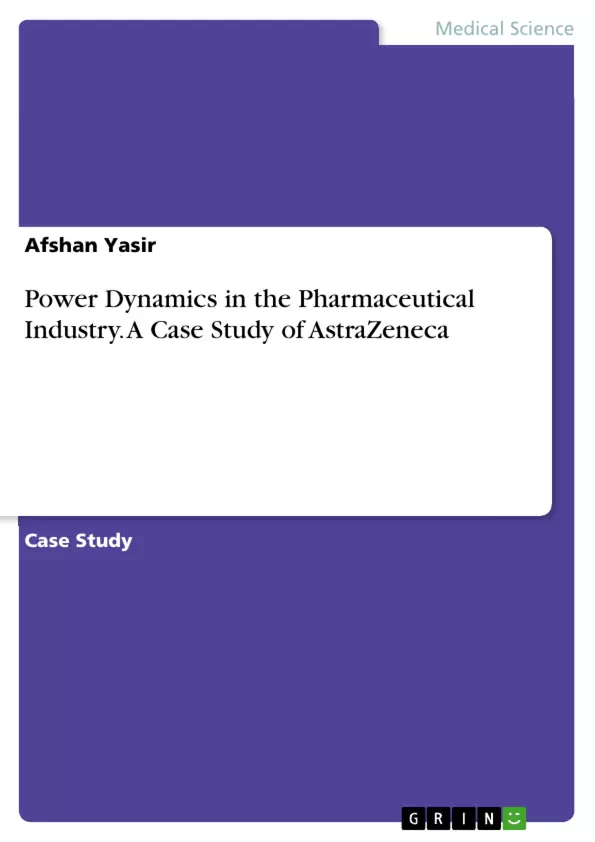This case study delves into the complex power dynamics within AstraZeneca, one of the most influential pharmaceutical corporations globally. It explores how the company wields power within the healthcare industry, impacting health improvements, lifestyle changes, and stakeholder interactions. The analysis focuses on AstraZeneca’s internal structure, sources of power, key stakeholder relationships, and the regulatory framework that governs its activities. By examining the intricate nature of power within the organization, this study provides insights into how AstraZeneca navigates its prominent role in the pharmaceutical sector and the broader implications of its influence.
Inhaltsverzeichnis (Table of Contents)
- Introduction
- AstraZeneca - an overview
- Merger and early growth
- The 2010s
- The 2020s
- The Present day
- Exertion of Power
- Research and development
- Manufacturing
- Lobbying
- Remit
- AstraZeneca's Power Structure
- Ownership
- Management
- Accountability
- Relationships with the Stakeholders
- Patients
- Health Professionals
- Government and Regulators
- The Major Sources of Organizational Power
- Size and Market Capitalization
- Global Reach
- Legal Incorporation and Corporate Governance
- Structural Integrity
- Inter-organizational Power Patterns
- Power Limitations
- Adherence to Legal Structures
- Ethical Considerations Pertaining to Marketing Practices and Trials
- The Dynamic Regulatory Landscapes
- Areas of Future Research
Zielsetzung und Themenschwerpunkte (Objectives and Key Themes)
This case study delves into the intricate power dynamics within AstraZeneca, a prominent pharmaceutical corporation. It examines the company's activities, internal structure, stakeholders, sources of power, and regulatory framework. The analysis focuses on how AstraZeneca exercises power within key stakeholder groups, explores the origins of its power, and examines the regulatory environment that shapes its operations.
- The exercise of power within AstraZeneca, focusing on activities, internal structure, stakeholders, sources of power, and regulations.
- The organization's exertion of power within key stakeholders, particularly patients, health professionals, and government and regulators.
- The sources of AstraZeneca's power, including its size, global reach, legal incorporation, and structural integrity.
- The regulatory landscape surrounding AstraZeneca and its impact on the company's activities.
- The limitations on AstraZeneca's power due to legal structures and ethical considerations.
Zusammenfassung der Kapitel (Chapter Summaries)
- Introduction: This chapter introduces the pharmaceutical industry as a powerful force in the world, particularly due to its impact on health improvement and life-saving drugs. It highlights AstraZeneca's significant influence in the healthcare industry and sets the stage for the case study, which aims to dissect the intricacies of power within the organization.
- AstraZeneca - an overview: This chapter provides a historical overview of AstraZeneca's formation through the merger of Astra AB and Zeneca Group PLC. It outlines key milestones in the companies' individual histories, including the development of important drug products like Bisodol, Xylocaine, and Zantac.
- Merger and early growth: This chapter focuses on the pivotal merger of Astra AB and Zeneca Group PLC, highlighting the creation of a diversified pharmaceutical company with a global outlook. It discusses the early years following the merger, including efforts to integrate the companies, restructure operations, and invest heavily in research and development. The chapter also acknowledges challenges faced by AstraZeneca during the 2000s, such as patent expirations and competition from generic drug manufacturers.
- The 2010s: This chapter explores AstraZeneca's renewed focus on research and development during the 2010s, emphasizing its investments in key areas like cancer and immunotherapy. It details notable acquisitions, such as MedImmune and Acerta Pharma, which expanded the company's product portfolio and pipeline.
- The 2020s: This chapter examines AstraZeneca's pivotal role in the global fight against COVID-19, highlighting its partnership with Oxford University to develop and supply a vaccine. It also discusses the company's ongoing development of new products like Enhertu and Evusheld.
- The Present day: This chapter presents AstraZeneca as a leading pharmaceutical firm in the UK, boasting a diverse product range and significant revenue generation. It emphasizes the company's continued dedication to research and development, striving to create new medicines for improving patient lives.
- Exertion of Power: This chapter delves into AstraZeneca's influence in pharmaceutical research and production, attributing its power to its strong drug portfolio, therapeutic innovations, and strategic partnerships. It focuses on the company's cutting-edge vaccine development efforts, particularly its role in addressing international health emergencies.
- Research and development: This chapter highlights AstraZeneca's substantial investment in research and development, showcasing its dedication to developing new medicines and vaccines. It details the company's R&D spending and the resulting successful products, such as Lynparza, Imfinzi, and Enhertu.
- Manufacturing: This chapter examines AstraZeneca's global manufacturing network, outlining its key advantages, including economies of scale, flexibility, and cost-effectiveness. It emphasizes the company's ability to produce products in large quantities and adjust production to meet varying demands across different countries.
- Lobbying: This chapter explores AstraZeneca's lobbying activities, which focus on securing conducive policies from governments and regulators. It outlines the company's strategies for influencing pricing, intellectual property protection, and market access.
- Remit: This chapter highlights AstraZeneca's mission to research and produce prescription medicines and vaccines, which grants the company significant control over the supply of essential drugs to patients. It discusses the benefits associated with this control, including the ability to charge high prices and influence drug usage.
Schlüsselwörter (Keywords)
Key terms and topics central to this analysis include pharmaceutical industry, power dynamics, organizational structure, stakeholders, sources of power, regulatory framework, research and development, manufacturing, lobbying, intellectual property, market access, global reach, and ethical considerations.
- Citation du texte
- Afshan Yasir (Auteur), 2023, Power Dynamics in the Pharmaceutical Industry. A Case Study of AstraZeneca, Munich, GRIN Verlag, https://www.grin.com/document/1498046



